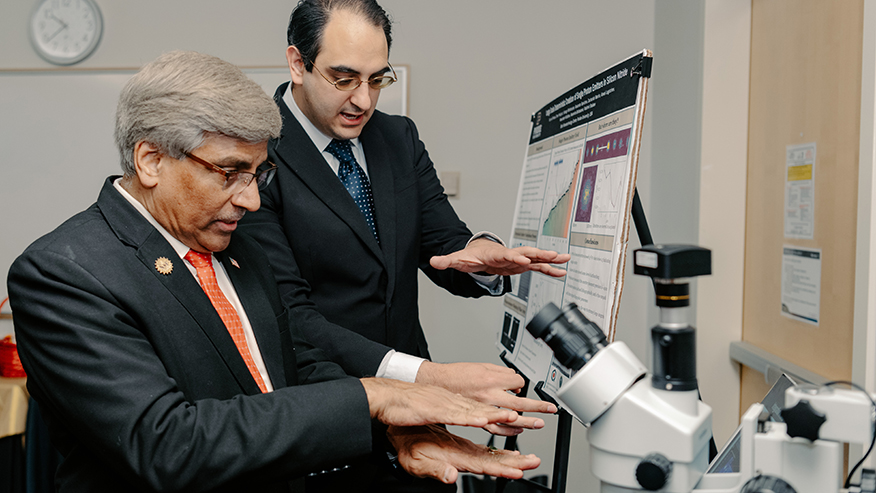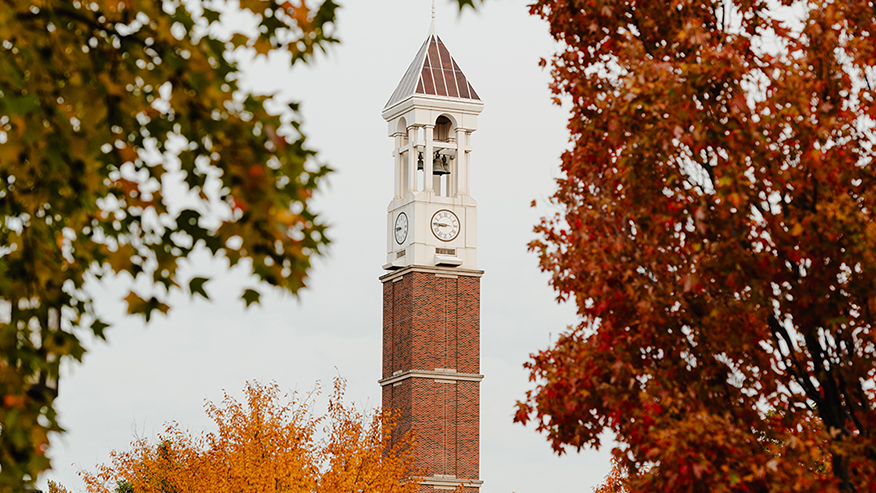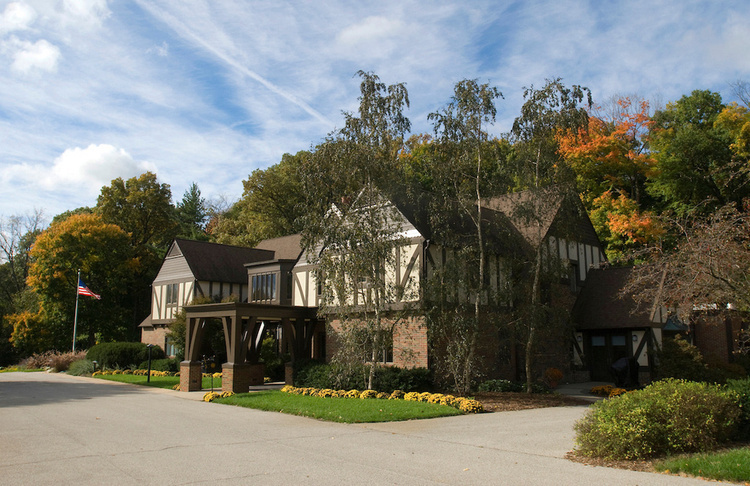PhD student who dreamed of being an inventor and builder is now making strides in world of quantum photonics
Achievements, honors for electrical engineer Samuel Peana now will include a 3-year Truman Fellowship at Sandia National Laboratories in New Mexico

Purdue electrical and computer engineering PhD candidate Sam Peana, right, discusses his research focused on nanostructured single photon emitters with Sethuraman Panchanathan, director of the National Science Foundation, during his recent campus visit, which included a stop at Birck Nanotechnology Center. (Purdue University photo/Kelsey Ann Lefever)
Growing up, Samuel Peana loved to build things. The world was his playground for tinkering and taking apart common things and discovering how they work — especially the inner workings of computers and potential interconnections between computers and robots, an interest sparked by his father, who was an engineer for Motorola.
“As long as I can remember, I think the job description I wanted was as an inventor. I wanted to design and build things that nobody had done before,” Peana says.
Peana (pronounced Payn-yuh) graduated this spring with his PhD in electrical engineering from Purdue University. Commencement ceremonies in May culminated Peana’s nine-year academic journey studying how to create optically driven microrobotic actuators based on shape memory alloy thin films integrated with plasmonics while also researching the challenging field of integrated quantum photonics.
For his doctoral dissertation, Peana was part of a Purdue team including Zachariah Martin and Alexander Senichev that discovered a type of single photon emitter that occurs at the interface of silicon nitride and silicon dioxide after being rapidly heated. The research has applications and major implications for quantum mechanics.
Decorated with several scholarships, fellowships and awards during his young career, Peana also won a College of Engineering 2024 Outstanding Research Award, which recognizes graduate students who have demonstrated excellence and leadership in research through publications, participation in professional organizations and a willingness to mentor others. And the honors keep coming: This spring, he was awarded a three-year Truman Fellowship from Sandia National Laboratories to continue his research and postdoctoral studies, beginning this October, at the U.S. Department of Energy facility in Albuquerque, New Mexico.
“Building on my terrific experience at Purdue, I’m excited about the opportunity to continue my research as a Truman Fellow at Sandia, which has one of the nation’s best research foundries,” says Peana, who looks forward to a career in deep tech research in either academia or industry.
Additional Information
Sparking a love of learning, computers, technology
Raised by a mechanical engineer father and a mother now pursuing a doctoral degree, Peana was destined to be an innovator and builder, growing up in a variety of places including Florida, Ireland, Arizona and southwest Missouri.
“When we were living in Arizona, my father had this drawer filled with these old junk computers. He said, ‘Look, this is a motherboard, there’s the processor.’ And I thought, this is the coolest thing ever,” he says. Later, Peana recalls finding a textbook on his father’s bookshelf that explained Microsoft Visual Basic 1.0, one of the world’s most widely used computer programming languages for the MS-DOS operating system.
“I had seen the book, flipped through it and was confused what it was. Then, one day I suddenly realized that this book explains how computers are instructed and then got it down from the shelf and started to learn from it,” he says. “The whole summer, I would wake up each morning, read the book and practice because I wanted to learn how to program computers.”
After consulting with a robotics engineer at work, Peana’s father purchased for his precocious 13-year-old a Parallax Propeller multicore microprocessor that quickly became his newest obsession. “It was an 8-core processor, so you could program it to run eight simultaneous tasks. I remember going to sleep thinking about programming and then waking up thinking about it,” he says, eventually making a variety of devices including multichannel synthesizers; a clap-on, clap-off controller for his bedroom lights; and a simple wheeled robot.
Valedictorian at Central High School in 2010, Peana was accepted at the Massachusetts Institute of Technology, where he earned an undergraduate degree in physics and mathematics in 2014. There he gained an introduction to professional research, working as an undergraduate researcher with professors Markus Klute, Peter Fisher and Linda Sugiyama at MIT’s Laboratory for Nuclear Science.
Becoming Boilermaker
With a foundation laid in the fundamentals of science, he was ready for a step into engineering — to transfer the knowledge of physics and math into real-world applications and technology solutions. While still not sure what his doctorate would entail, he knew it would center on engineering. And he was excited about the potential Purdue offered with its tradition as one of the nation’s best engineering universities and the state-of-the-art research facilities it afforded students, especially the Birck Nanotechnology Center.
Awarded Purdue’s prestigious Ross Fellowship, which comes with four years of stipend, salary and tuition coverage for the winning doctoral applicant, Peana had the flexibility to develop an independent, long-term research vision. And, unlike most of his peers, he arrived at Purdue without an advisor. “So, I showed up and I’m just floating around, which was a very good thing because I was able to explore the whole ECE department. I examined all the different faculty members that were doing things that I thought were interesting.”
Inspired by what he saw, he developed a novel approach for the development of optically driven microrobotic actuators. Given the breadth of this work, Peana pursued two PhD co-advisors: Vlad Shalaev, the Robert and Anne Burnett Distinguished Professor of Electrical and Computer Engineering; and Dana Weinstein, an electrical and computer engineering professor and associate dean of graduate education. Shalaev’s group Nanometa consists of up to 25 researchers and focuses heavily on nano-optics and photonics. Weinstein’s group is focused on micro-electromechanical systems.
This combination of expertise that both advisors brought to the table were critical for Peana. He worked on his microactuator research program until the startling discovery of single photon emitters in silicon nitride, which prompted a radical shift in his research toward integrated quantum photonics for his PhD thesis. Since silicon nitride on silicon dioxide is a common platform for integrated photonics, the discovery of a native emitter in this platform creates for the first time the possibility for seamless integration of single photon emitters with silicon nitride photonic circuitry without requiring additional materials. A single photon emitter emits light as single particles or photons distinct from classical light sources that emit multiple photons of light at a time. Such sources of single photons are critical for quantum optical applications.
“We can make integrated photonic circuits at a large scale, 200 millimeters. But the emitters are so new that most of the material science and physics of these emitters is not understood; we don’t even know what forms there,” he says. “It’s like a mystery. There are all these clues. You know something happened, but you don’t know why. We go step by step trying to understand exactly what happened.”
In his research, Peana discovered that if silicon nitride on silicon oxide is nanostructured into nanopillars and annealed, a single photon emitter forms over 65% of the time within the nanopillar. This discovery, he says, has generated excitement for the inherent scalability of this approach and its applications for developing very large scale integrated on-chip quantum photonic systems.
“This leap in experimental capability and scaling is exciting because we’re beginning to operate and do experiments at the level of single atomic objects, and that means we’re manipulating matter, we’re measuring matter at a level that has never been done before, that was thought not possible,” he says. “This will deepen our understanding of matter and how to work with it, leading to technologies that we don’t even have names for yet.”
What awaits Truman Fellow at Sandia
Knowing his PhD student for nearly a decade now, Professor Shalaev says Peana has made a significant impact on Purdue and his research field during his time here — proven by his numerous awards, including the exceptionally competitive Truman Fellowship from Sandia National Labs. “Not only is he a great young researcher, Dr. Peana is also very cultural. He plays saxophone, is interested in history, literature and arts. And on top of that, he is an extremely warm, friendly and nice person with a great sense of humor — a true soul of our research team,” Shalaev says. “He is a rare gem, and we’re happy to have him as our team member.”
Noted as one of the nation’s best research foundries, Sandia is focused on research and development responsibilities in nuclear deterrence, global security, defense, energy technologies and economic competitiveness. While Birck, the home for Peana’s research over the past several years, is a high-end research facility for initial exploration, he says, Sandia will allow him to advance his efforts, specifically investigating how to manufacture the emitters at a large scale for potential quantum technology applications.
Researchers, Peana says, have achieved making single photons. But that’s just a start for making quantum devices. After 40 years of research, scientists and engineers are now able to do this with two quantum dots. But anything that requires entanglements among different emitters is extremely challenging.
“You need the photons that come out to be identical, and you need large amounts of them. And when you start looking at quantum computing, for example, we can manufacture emitters,” he says. “But a lot of research is still needed for optimizing their performance — so that the photons that come out are exactly the same so we can control the wavelength that they emit at, to improve their stability and brightness. We’re still down in the basement level on the development work for this.”
Building on his work at Purdue, a key first step in continuing his research at Sandia, Peana says, is to determine why these emitters form and to understand what the emitter actually is. Next, he’ll test different parameters, materials, temperatures and their annealing properties to see if the emitter’s brightness can be controlled while remaining stable and, most importantly, indistinguishable — where the photons generated are identical. “If we’re really swinging for the fences, we want to show we can make multiple ones and have strong quantum interference between them,” Peana says. “That would be shocking if it actually works because no other solid-state emitter can do that now at scale.”



